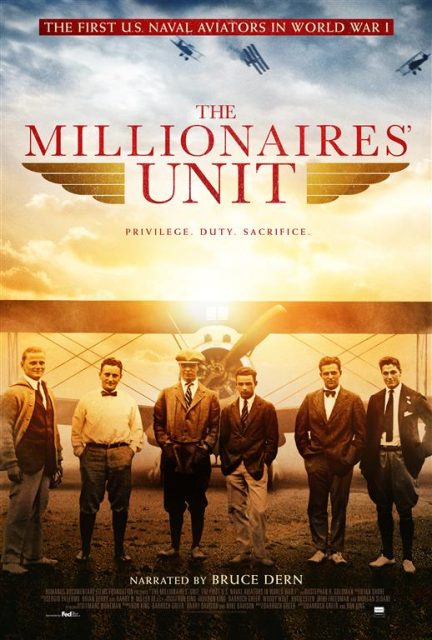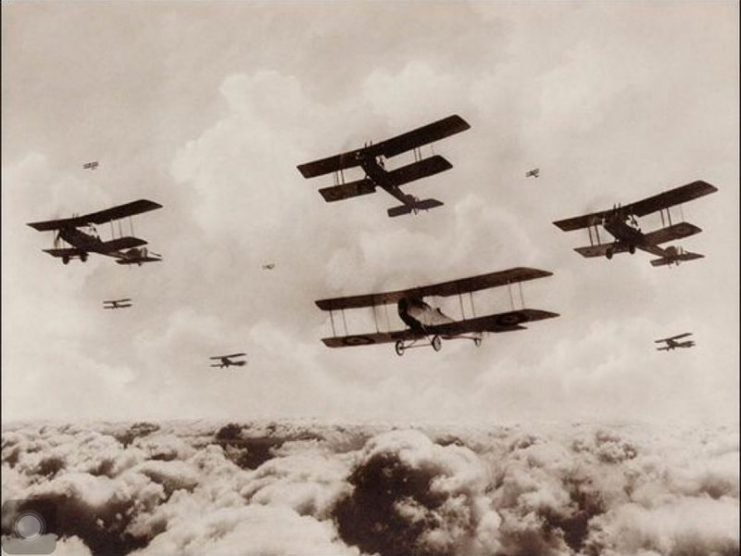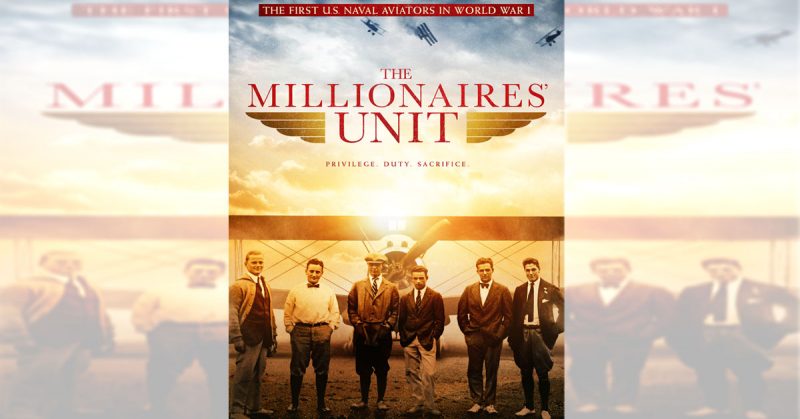The Millionaires’ Unit tells the unsung story of a group of Yale college students who took the initiative to learn to fly in preparation for America’s entry into World War I and became the founding squadron of the U.S. Naval Air Reserve.
The award-winning film’s VOD release date of February 15, 2018 was chosen to commemorate the 100th anniversary of the death of First Yale Unit member Albert D. Sturtevant, the first U.S. Naval Aviator killed in combat, when his plane went down in the North Sea on February 15, 1918.
Narrated by Academy Award®-nominated actor Bruce Dern, grandnephew of one of the aviators, the feature-length documentary charts the romantic, little-known story of the origins of American airpower and features very rare archival footage and thrilling dogfighting sequences filmed air-to-air with replica WW1 planes, some with original engines.
Inspired by Marc Wortman’s book The Millionaires’ Unit, the film has been developed and produced by descendants of the First Yale Unit, including filmmaker Ron King, producers Harry Davison and Mike Davison, and narrator Bruce Dern who are all grandnephews and grandsons of FYU members.

Director’s Statement
By Darroch Greer
Writer and co-director, The Millionaires’ Unit – The First U.S. Naval Aviators in World War I
As the writer and co-director of The Millionaires’ Unit documentary, I wanted historical elements to tell the story as much as possible. I generally don’t like to see re-enactors in a historical documentary; it kills the imagination. I like to see the tangible materials of history on screen. The letters, diaries, telegrams, photos and memorabilia of the Unit aviators and their families were so plentiful and rich that their stories could be illustrated with a very tactile feel of the time. The interplay of these real objects with film of the real places—both archival and new—evokes the past better than people running around in costumes. Filming the actual sites in America and Europe where the young pilots trained, flew, fought and died was particularly moving.
Happily, we filmmakers fell in with aviation historians and early aviation practitioners, as well as the families of the First Yale Unit members, all of whom helped us tell a character-driven story. We got to know two of the world’s most experienced pilots in flying exact replica World War One aircraft, many of them with original engines. We travelled to New Zealand and got to work with Sir Peter Jackson’s incomparable collection of WWI aeroplanes. We were given discounts renting cameras, tripods and stabilizers, camera planes and helicopters, replica planes and pilots—all in the service of depicting what it took to fly WWI aircraft in battle and making it as visceral an experience as possible. We hope we’ve succeeded in bringing this bygone era of a century ago to life, so that audiences can understand what our predecessors did to significantly shape the nation we are today.

By Ron King
Co-director, The Millionaires’ Unit – The First U.S. Naval Aviators in World War I
In the fall of 2006, I stumbled across a just published book by Marc Wortman called The Millionaires’ Unit. There was a photograph of my grandfather, John M. Vorys, on the cover that I had never seen before, but his face at age 20 in 1916 was immediately recognizable and I knew in an instant what the story was about. Not long after, I was in touch with Mr. Wortman and asked if anyone was making a documentary because I really wanted to see it. When he informed me that no one was making a film of the story to his knowledge, that put the notion in my mind that maybe I could do so; and thus began the seven year journey to bring the story of the first U.S. naval aviators in World War I to the screen.
The project is important because it reminds us of a time when people of privilege felt it was incumbent upon them to give back to the community who had afforded them so much. In this case, it was a group of young men who decided to put themselves on the line, defending the interests of the United States in World War I. They did so with a spirit of high adventure and in fact suffered the fate of three of their members who were lost in the war effort.
The production of the film created a new community of family members descended from the members of the First Yale Unit who shared their enormously valuable archives of photographs, letters, diaries and other ephemera from the period. It turns out that the story of the First Yale Unit is dear to their hearts and all were more than willing to share the experiences of their forbearers in the film. As a filmmaker and a First Yale Unit descendent myself, I was in a unique position to gain the trust of other family members that the story would be told with as much care as they would do so themselves.
Many great documentaries inspire me but I’d have to point to the work of Ken Burns as being particularly inspirational. The Civil War is an amazing epic, which successfully illuminated a poignant and personal view set in the context of a cataclysmic event. I also found inspiration from the first IMAX film I ever saw, To Fly, that brilliantly achieved the awe-inspiring experience of flight. I thought if we could get just an inkling of that experience into our film we’d be doing alright.
Though some might feel that seven years is a long haul for the making of a documentary, in fact it was the revelation of undiscovered resource material over that period that enriched the film. To sight one example, after reading the transcript of an oral history by his grandfather describing a 1914 hunting expedition to Alaska where he was first informed of the war, one of our producers realized that he had discovered visual gold in the form of a photo album in his attic. The album surfaced in the sixth year of production and images from it now take a prominent role in our film.
My hope for the film is that a contemporary audience will come to know a few of the members of the First Yale Unit highlighted in the film and will find a shared humanity with them. Though some of the members of the First Yale Unit may have been far more well off than the rest of us, their desire to fight for their country and their willingness to take the risks associated with their chosen line of service is something I think most everyone can identify with and take pride in.
The Millionaires’ Unit — originally envisioned to last 90 minutes and take three years to make — is now a two -hour epic film, filmed at locations on the Eastern Seaboard and across Western Europe and on the other side of the world. It tells an intimate, character-driven story set in the historical context of the United States one hundred years ago, the birth of naval aviation, and the drama and tragedy of the First World War. It took seven years, but the film is now ready to help commemorate the centennial of World War One.
